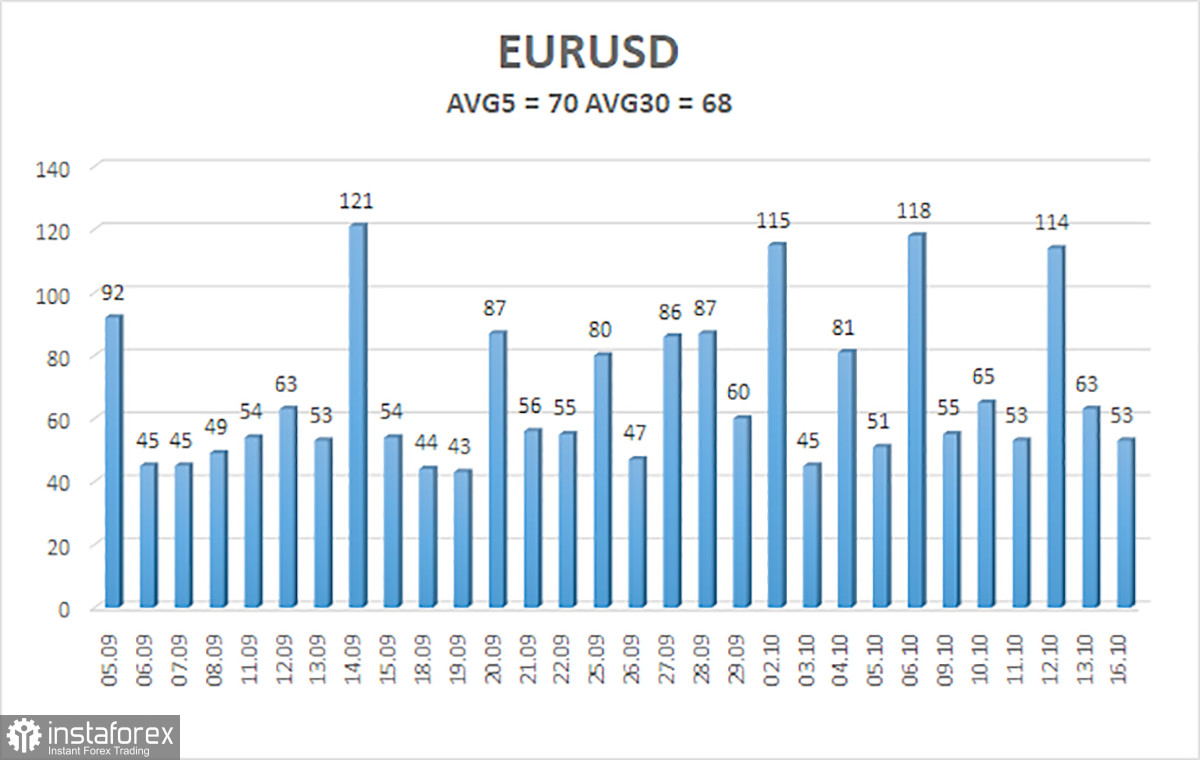
The EUR/USD currency pair recovered to the moving average line on Monday, and now the key question is whether it will breach it once more, which would open the way for further corrections for the euro. We have repeatedly mentioned that we advocate the continuation of the correction, as we believe that a move of 180 points is insufficient to consider the correction completed. However, it should be understood that the market consists of a vast number of participants, and their collective or weighted average opinion may differ from ours. Currently, in the 4-hour timeframe, there is a higher probability of a resumption of the short-term downtrend. Still, at the same time, two bounces from the Murray level "6/8" at 1.0498 indicate the market's inclination towards correction.
On Monday, no important data was made available to traders. No significant macroeconomic reports were published, and no major events occurred. As usual, several representatives of the Federal Reserve and the European Central Bank spoke, but they did not surprise or please the market. As we have already mentioned, at this time, central bank comments and statements are not significant for the market because the situation with interest rates and tightening programmes is clear at 95%. What can Draghi, Lagarde, Bostic, or Powell say that's new? Neither the Fed nor the ECB is ready to continue aggressive tightening; inflation is slowly decreasing, and there are no new economic catalysts. Therefore, the fundamental background is neutral at the moment.
For the euro and the pound, this means that there are no new reasons for growth. Both European currencies rose for a long time, but then the question arose: why were they rising? And now the market is busy "restoring justice." Therefore, both the euro and the pound may continue to decline calmly over the next few months.
Christine Lagarde acknowledges the presence of inflation concerns but remains hesitant to implement any immediate actions. While Christine Lagarde's speeches consistently draw attention, her recent address in Morocco lacked substantial announcements. Although she highlighted elevated core inflation and rapid wage growth, factors contributing to increased inflation, she refrained from outlining any additional measures to tighten monetary policy. Essentially, her speech conveyed the message that they recognize the existence of a problem but are currently unable to address it.
Throughout 2023, we have consistently emphasized that the European Central Bank (ECB) faces challenges in matching the key interest rates of the Federal Reserve or the Bank of England. The European Union comprises 27 member states, each with unique interests to consider. Implementing an excessively high interest rate could potentially harm economies with weaker foundations. Consequently, the ECB cannot readily raise rates to the 5.5-6.0% range.
As a result, the ECB's most viable course of action is to sustain interest rates at the highest feasible level for an extended duration, a strategy that will occupy the ECB's focus in the coming one, two, or three years. This, however, does not provide any compelling reasons for the euro to appreciate, particularly considering that the Federal Reserve may increase its rate to 5.75% within this year. It is possible that, when U.S. inflation eventually falls below 3%, discussions about monetary policy easing may emerge. At that juncture, the U.S. dollar could face market pressure, as lowering interest rates typically has a "bearish" impact on a currency. However, for the present, such discussions are absent, and the current situation is proceeding as anticipated. We maintain our belief that the euro may depreciate to the 1.02 level by year-end.
Therefore, the main question for today is whether the moving average will be overcome. The answer to this question will determine the pair's movement this week. Either the correction will continue (which would be logical) or the downtrend will resume (which would also be logical).

The average volatility of the Euro/USD currency pair over the past 5 trading days as of October 17th is 70 points and is characterized as "average." Thus, we expect movement between the levels of 1.0480 and 1.0620 on Tuesday. A reversal of the Heiken Ashi indicator downward will indicate a possible resumption of the downtrend.
The nearest support levels:
S1 – 1.0498
S2 – 1.0376
S3 – 1.0254
Nearest resistance levels:
R1 – 1.0620
R2 – 1.0742
R3 – 1.0864
Trading recommendations:
The EUR/USD pair has moved back below the moving average. Therefore, short positions can be considered with targets at 1.0438 and 1.0376 in case the price rebounds from the moving average line. Long positions can be considered if the price firmly establishes itself above the moving average with targets at 1.0620 and 1.0742, but we still do not expect a strong rise in the euro; at most, it will be a correction.
Explanations for the illustrations:
Linear regression channels - help determine the current trend. If both are pointing in the same direction, it indicates a strong current trend.
Moving average line (settings 20.0, smoothed) - determines the short-term trend and the direction for trading.
Murray levels - target levels for movements and corrections.
Volatility levels (red lines) - the probable price channel in which the pair is likely to trade over the next day, based on current volatility indicators.
CCI indicator - its entry into the overbought area (above +250) or oversold area (below -250) indicates an approaching trend reversal in the opposite direction.
 English
English 
 Русский
Русский Bahasa Indonesia
Bahasa Indonesia Bahasa Malay
Bahasa Malay ไทย
ไทย Español
Español Deutsch
Deutsch Български
Български Français
Français Tiếng Việt
Tiếng Việt 中文
中文 বাংলা
বাংলা हिन्दी
हिन्दी Čeština
Čeština Українська
Українська Română
Română

